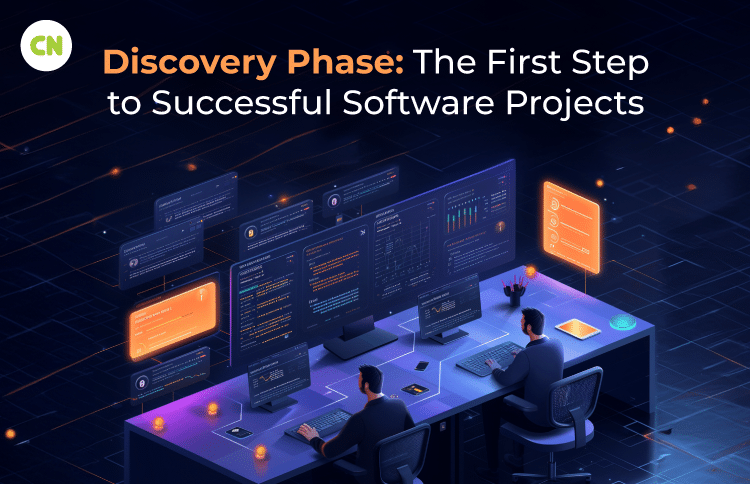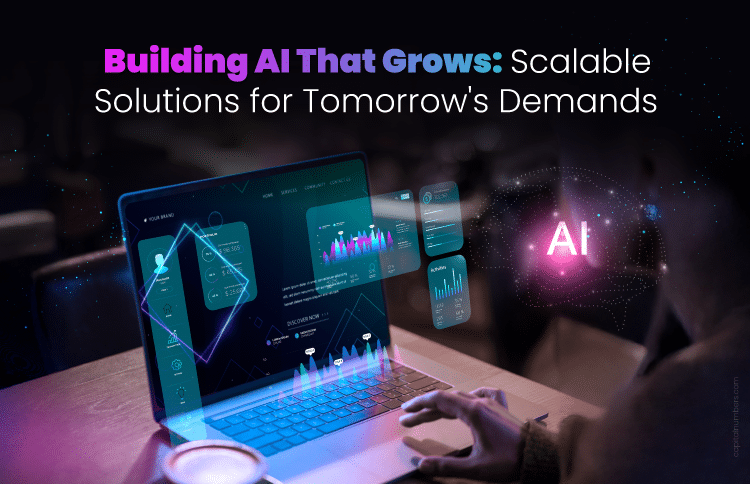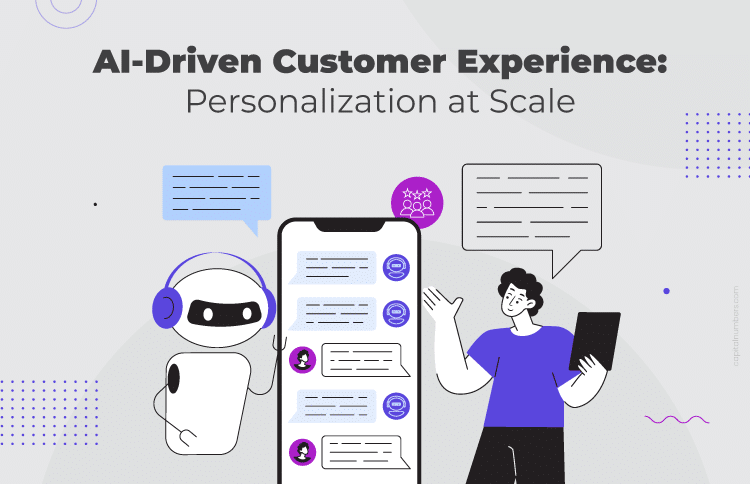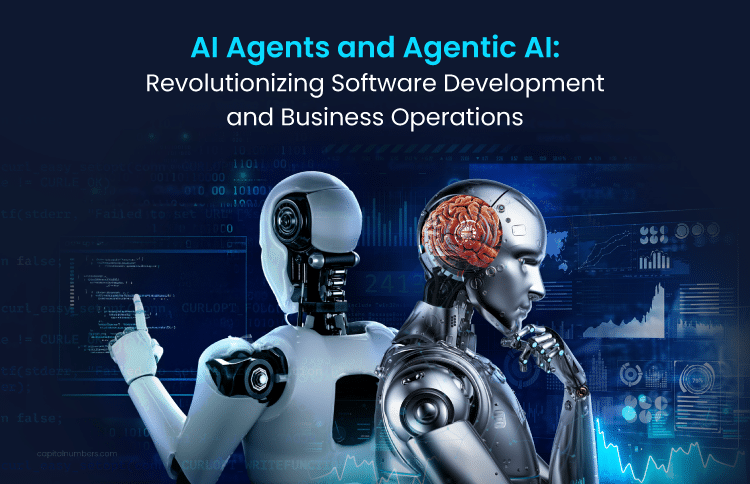Discovery Phase: The First Step to Successful Software Projects
Table of Contents
The Discovery Phase is the initial stage of any software development project, acting as the strategic process that determines the project’s direction. This phase involves in-depth analysis and documentation of business needs, user expectations, and system requirements. Its core purpose is to elaborate on the high-level idea, transforming it into detailed, actionable tasks and deliverables. During this phase, development teams, along with stakeholders, gather to define the problem, explore solutions, and identify the project scope and constraints. The outcomes of this phase include a clear project roadmap, budget estimations, and a feasibility report.
The Discovery Phase is a critical component of custom software development that can dictate the overall success of the project. By investing time in the Discovery Phase, teams can avoid common pitfalls such as scope creep, budget overruns, and misaligned objectives. For software developers, fully understanding the project’s scope from the beginning ensures the selection of appropriate technologies and frameworks, which promotes efficient and effective development practices. For agencies, this phase provides a structured approach to managing client expectations and ensuring that project deliverables are achievable within the established constraints and timelines.
Curious how the Discovery Phase can set your software project up for success? Let’s break it down step by step.
What is the Discovery Phase?
The Discovery Phase is often considered the blueprint stage of software development, where all necessary project details are gathered and analyzed. This phase is dedicated to understanding the project’s business context, defining user needs, and aligning these insights with technological capabilities. Its main objectives include:
- Clarifying project vision and scope: To detail what the project aims to achieve and outline the boundaries within which it must operate.
- Identifying user requirements: To gather precise information about the end-users’ needs, preferences, and expected functionalities.
- Setting feasibility and project parameters: To assess the practical aspects of the project, including technical feasibility, time estimations, and budget considerations.
Looking to build feature-rich software that perfectly reflects your brand?
Get custom software development services from us to create powerful, tailored solutions that drive your business forward and strengthen your brand’s presence.
Comparison with Other Project Phases (Planning, Execution, Delivery)
- Planning: Follows discovery; it involves outlining the project strategy, resources, timelines, and detailed plans needed to achieve the defined objectives. While Discovery focuses on what and why, Planning focuses on how.
- Execution: This is where the plans are put into action. Development teams create the software according to specifications developed in earlier phases. Execution is heavily dependent on the clarity and accuracy of the Discovery and Planning phases.
- Delivery: Involves deploying the finished product to the end-users and maintaining ongoing support and updates. The success of this phase is largely contingent on the thoroughness of the Discovery phase to ensure the final product meets user expectations.
The Role of the Discovery Phase in Agile vs. Waterfall Methodologies
- Agile Methodology: In Agile, the Discovery Phase is not a one-time effort but a cyclic process that recurs throughout the project lifecycle. Agile projects treat Discovery as an evolving element where requirements and scope are refined in each iteration based on feedback and learning. This flexibility allows Agile teams to adapt to changes and innovations more dynamically.
- Waterfall Methodology: The Discovery Phase in Waterfall is a linear and one-time process that precedes all other phases. All requirements and project scopes are determined upfront, with little scope for change once the project moves to the next phase. The comprehensive and rigid structure of the Discovery Phase in Waterfall makes it crucial for capturing all possible contingencies and requirements at the beginning.
In both methodologies, the Discovery Phase plays a vital role, but its integration and flexibility vary. Agile allows for ongoing discovery, promoting adaptability and responsiveness, while Waterfall emphasizes a thorough and fixed discovery to prevent changes later in the project. For both software developers and agencies, understanding these distinctions is key to selecting the right approach for managing and implementing software projects effectively.
You May Also Read: Agile vs. Waterfall: Which Development Methodology Should You Choose?
What Are the Key Components of the Discovery Phase?
The discovery phase of a software development project includes several key components that help lay the foundation for a successful outcome. Here are the core ones:
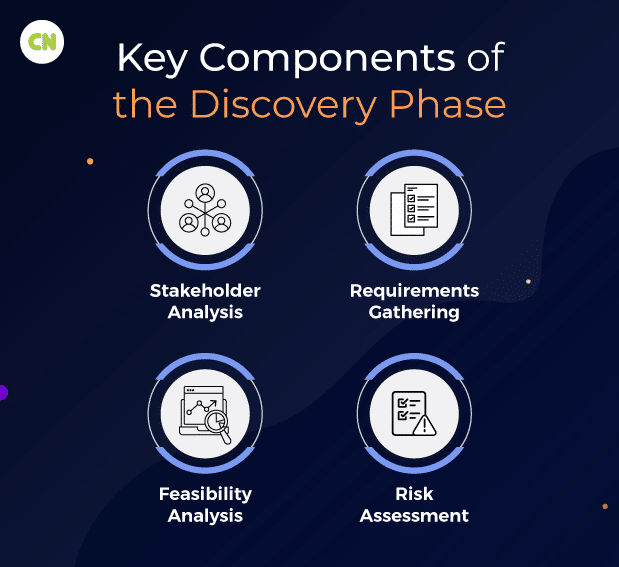
Stakeholder Analysis
- Identifying Stakeholders: This involves pinpointing all parties who have an interest in the outcome of the project, including clients, end-users, project managers, software developers, and third-party vendors. The identification process helps in understanding the influence and interests of each stakeholder to better align project goals.
- Methods for Engaging Stakeholders: Effective engagement can be achieved through structured interviews and interactive workshops. Interviews allow for deep dives into individual expectations and concerns, while workshops facilitate collaborative discussion and consensus-building. Both methods are crucial for ensuring that stakeholder perspectives are accurately incorporated into the project planning.
Requirements Gathering
- Techniques for Effective Requirements Collection: Utilizing user stories and use cases are powerful techniques for capturing functional requirements. User stories make it easy to express user needs by directly stating what the user wants and why, such as “A customer wants to track their order to know when it will arrive”. Use cases, on the other hand, offer detailed interactions between the user and the system, describing every possible success and failure scenario in a step-by-step process.
- Tools to Aid the Process: Tools like JIRA and Confluence enhance the efficiency of capturing, organizing, and tracking requirements. JIRA allows for detailed issue tracking and agile project management, facilitating the breakdown of requirements into actionable tasks. Confluence serves as a collaborative knowledge repository where all project documentation (including user stories and use cases) can be centrally managed and accessed.
Feasibility Analysis
- Technical Feasibility: This assessment determines whether the current technology stack and software architecture can support the proposed solutions or if new technologies need to be adopted. It also involves evaluating the integration capabilities with any existing legacy systems, ensuring compatibility and smooth data flows between new and old systems.
- Economic Feasibility: Conducting a cost-benefit analysis is essential to determine whether the projected benefits of the project justify the estimated costs. This analysis helps stakeholders understand the financial viability and potential ROI of the project, aiding in informed decision-making.
Risk Assessment
- Identifying Potential Risks: This component involves the identification of all conceivable risks that could impact the project negatively. These risks can be technical (e.g., technology obsolescence, security vulnerabilities), project-related (e.g., scope creep, resource availability), or operational (e.g., user adoption hurdles).
- Mitigation Strategies: Once risks are identified, developing strategies to mitigate them is crucial. This might involve establishing contingency plans, defining risk management protocols, and setting up early warning systems to manage and minimize the impact of these risks.
Each of these components plays a vital role in the Discovery Phase, collectively ensuring that the project is thoroughly scoped, technically viable, economically justified, and resilient to risks. For software developers and agencies, mastering these components means they can deliver projects that meet or exceed stakeholder expectations while adhering to budget and timelines.
You May Also Read: Offshore Software Development in 2025: Myths vs. Facts
What Are the Deliverables of the Discovery Phase?
The discovery phase of a software project has several key deliverables that define the project’s direction and ensure alignment with business goals. Here are the main deliverables:
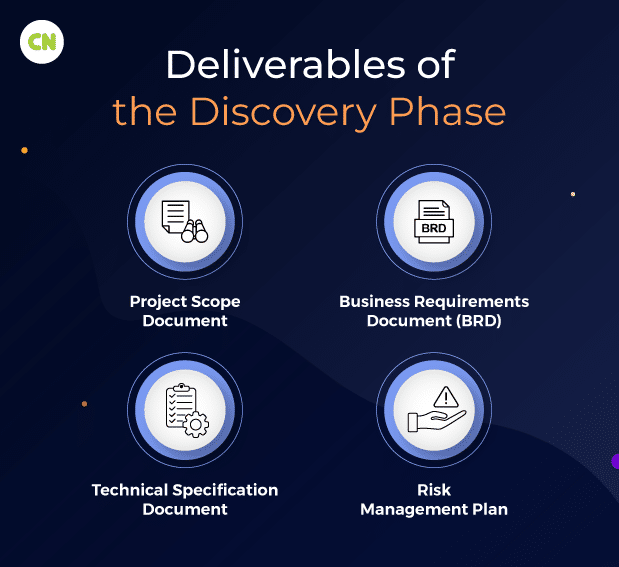
1. Project Scope Document:
This document should serve as the definitive guide for what the project will deliver and what it won’t. It typically includes project objectives, deliverables, milestones, and the features to be developed, as well as any limitations or exclusions. To ensure clarity, use clear, concise language and include visual aids like diagrams and charts. Break down the project into manageable components and specify the criteria for completion of each phase or deliverable.
2. Business Requirements Document (BRD):
A well-crafted BRD provides a detailed description of business objectives and the value they seek to create through the project. It should include:
- Business Context: Outline the environment in which the business operates, including key processes and systems.
- Business Objectives: Specify what the business aims to achieve with the project, aligning these with broader corporate strategies.
- Stakeholder Requirements: List detailed descriptions of stakeholder needs and expectations from the project.
- Business Logic and Rules: Describe the operational rules that define or constrain business processes.
- Success Criteria: Define what success looks like for the project and how it will be measured.
3. Technical Specification Document:
This document translates the BRD into technical terms. It should outline:
- System Architecture: Provide a high-level overview of the proposed system architecture, including major components and their interactions.
- Technology Stack: Detail the technologies, frameworks, and tools that will be used in the development process.
- Data Model: Include schemas for databases, relationships between data entities, and any constraints or triggers.
- Integration Requirements: Describe how the new system will integrate with existing software and platforms, detailing the interfaces and data exchange protocols.
- Security Specifications: Specify security requirements, including authentication methods, data encryption standards, and compliance with relevant regulations.
4. Risk Management Plan:
Examples of Risk Mitigation Measures:
- Technical Risks: Use prototyping or proof of concept to validate technologies before full-scale implementation. Regularly update and patch systems to avoid security vulnerabilities.
- Project Risks: Implement agile methodologies to manage changes effectively and maintain flexibility in project plans.
- Operational Risks: Prepare training programs and user manuals well in advance to facilitate smooth transitions and user adaptation.
- Risks: Conduct continuous budget reviews and have contingency funds to manage cost overruns.
Each of these documents serves a critical function in transitioning from the Discovery Phase to the subsequent phases of the project. They ensure that all team members—from software developers to stakeholders—are on the same page regarding the project’s scope, requirements, and procedures, thereby setting a solid foundation for successful project execution.
What Are the Tools Used for the Discovery Phase?
In the Discovery Phase, leveraging the right tools is crucial for effective project initiation, planning, and communication. Below is a detailed guide on the essential tools that can enhance the Discovery Phase of a software project:
Project Management Tools
- Asana: Asana is a versatile project management tool that helps teams organize and plan workflows, projects, and more. With Asana, teams can create projects, assign work to teammates, specify deadlines, and communicate about tasks directly in the platform. It offers a visual project timeline, project templates, and integration capabilities with other tools, making it ideal for tracking the progress of the Discovery Phase.
- Monday.com: This tool is known for its customizability and ease of use in managing complex projects. It allows teams to streamline contributions and centralize all project details in a single workspace. Monday.com features include time tracking, automated notifications, dashboards, and an intuitive interface that can support the multifaceted needs of a discovery phase in project management.
Communication and Collaboration Tools
- Slack: Slack facilitates real-time messaging, file sharing, and collaboration across teams. It can be integrated with a variety of other tools that teams might use, such as Asana and GitHub, allowing for seamless communication and updates related to the Discovery Phase. Channels can be set up for specific projects, topics, or teams, ensuring that discussions are organized and accessible.
- Microsoft Teams: This tool combines workplace chat, meetings, notes, and attachments. Microsoft Teams integrates with the Office 365 subscription office productivity suite and features extensions that can integrate with non-Microsoft products. It is particularly effective for real-time collaboration on documents, making it a robust platform for communication during the Discovery Phase.
Documentation Tools
- Google Docs: A cloud-based document service that allows multiple users to edit documents simultaneously and see each other’s changes in real-time. With Google Docs, project documents, such as the scope document or BRD, can be easily shared, edited, and commented on by all team members, facilitating an interactive approach to document creation and revision.
- Microsoft Word: Part of the Microsoft Office suite, Word offers advanced document creation features that are ideal for producing detailed and formatted documentation required in the Discovery Phase. It supports a range of content types and can be used to create everything from the project scope document to detailed technical specifications.
Diagramming Tools
- Lucidchart: This is a web-based diagramming software with strong collaboration features. Lucidchart allows users to create complex diagrams in a user-friendly interface and share them with team members for feedback and discussion. It is invaluable for creating flowcharts, process diagrams, and other visual representations that help clarify and document project requirements and designs.
- Microsoft Visio: A diagramming tool that offers advanced features, templates, and integration capabilities. Visio is used to create detailed diagrams that can depict project workflows, architectural frameworks, or network systems. It supports complex information visualizations, making it suitable for detailed technical diagrams needed in the Discovery Phase.
Utilizing these tools can greatly enhance the efficiency and effectiveness of the Discovery Phase, providing structured ways to manage projects, communicate within teams, document processes, and visually represent ideas and requirements.
You May Also Read: Top 10 Must-Have Software Development Tools for Tech Companies
What Are the Best Practices for Conducting the Discovery Phase?
The Discovery Phase sets the groundwork for the success of a software development project. Implementing best practices during this phase not only ensures that the project starts on a strong footing but also helps in avoiding potential pitfalls later on. Here are some technical best practices tailored for software developers and agencies to enhance the effectiveness of the Discovery Phase:
Involving the Right Stakeholders
- Identify Key Stakeholders: Begin by identifying all essential stakeholders, including end-users, project sponsors, development teams, and business analysts. Each stakeholder group will have unique insights and requirements that are critical to the project’s success.
- Engage Actively: Utilize structured interviews, focus groups, and stakeholder workshops to actively engage stakeholders in the discovery process. This helps in gathering diverse perspectives and ensuring that all voices are heard.
- Stakeholder Mapping: Use stakeholder mapping techniques to prioritize engagement based on influence and interest. This helps in managing stakeholder interactions more effectively, ensuring that key players are closely involved in the decision-making process.
Maintaining Clear and Open Communication
- Regular Updates: Establish a routine for regular updates and feedback sessions with stakeholders to keep everyone informed and involved. This can be facilitated through weekly meetings, email updates, or through collaborative platforms like Slack or Microsoft Teams.
- Transparent Processes: Make the documentation and decision-making processes transparent. Use tools like Confluence or Google Docs where documents can be accessed and edited collaboratively, ensuring that everyone is on the same page.
- Feedback Mechanisms: Implement effective feedback mechanisms to capture insights and concerns from all stakeholders. This could be through digital feedback forms, direct conversations, or interactive feedback sessions during meetings.
Prioritizing Requirements Based on Project Goals
- Requirements Traceability Matrix (RTM): Develop an RTM to link requirements back to project objectives. This ensures that each requirement directly contributes to the project’s goals and provides a clear rationale for requirement prioritization.
- MoSCoW Method: Use the MoSCoW method to categorize requirements into Must have, Should have, Could have, and Won’t have. This helps in focusing efforts and resources on what is most critical to project success.
- Iterative Review: Regularly review and refine the requirements with stakeholders to ensure they remain aligned with business goals and market dynamics. This iterative process is especially important in agile development environments.
Regularly Updating and Revising Discovery Phase Deliverables
- Version Control: Use version control systems to manage changes and revisions to documents created during the Discovery Phase. This ensures that there is a clear audit trail of what changes have been made, by whom, and why.
- Scheduled Reviews: Set up scheduled review points to reassess and update the deliverables as new information becomes available or as project parameters change. This dynamic approach allows the project to adapt to new insights or external changes affecting the project scope.
- Quality Checks: Conduct regular quality checks on the deliverables to ensure they meet the required standards and are free from errors. Peer reviews and checklists can be effective tools for ensuring the quality of documents such as the Project Scope Document and Technical Specifications.
By adhering to these best practices, software developers and agencies can maximize the efficiency and effectiveness of the Discovery Phase, setting a strong foundation for the subsequent phases of the project.
You May Also Read: Breaking the Complexity Cycle in Software Development to Boost Efficiency and Reduce Costs
How to Transition from Discovery to Project Planning?
Transitioning from the Discovery Phase to Project Planning is a critical step in the software development lifecycle, requiring careful execution to ensure seamless progression. This transition involves confirming that all groundwork laid during the Discovery Phase aligns with the expectations and requirements of all stakeholders. It also includes establishing robust governance for future project phases and securing formal approval to move forward. Here’s a technical breakdown of how software developers and agencies can manage this transition effectively:
Ensuring All Stakeholders Are Aligned with the Project Scope and Outcomes
- Stakeholder Alignment Workshops: Organize workshops or meetings specifically aimed at reviewing the project scope and outcomes with all stakeholders. This includes a detailed walkthrough of the Project Scope Document and other Discovery deliverables to confirm every element is understood and agreed upon.
- Requirement Validation Sessions: Conduct sessions where stakeholders can confirm that their needs and expectations are accurately captured and reflected in the project documents. Use techniques like prototyping or use case demonstrations to make abstract requirements more tangible.
- Scope Baseline: Once all inputs are gathered and consensus is achieved, establish a scope baseline which will serve as the official agreement on what the project aims to deliver. This document should be formally approved by all key stakeholders and locked down to prevent unauthorized changes.
Setting Up Governance Structures for the Next Phases
- Governance Framework: Develop a governance framework that outlines the roles, responsibilities, and decision-making processes for the project. This framework should include details on project management structures, communication protocols, and escalation paths for addressing issues.
- Project Control Groups: Set up control groups or committees such as a Steering Committee or a Project Management Office (PMO) that will oversee project execution. These groups are responsible for maintaining project alignment with strategic objectives, budgeting, scheduling, and resource allocation.
- Change Management Process: Implement a structured change management process to handle any requests for changes to the project scope or objectives. This process should include impact analysis, approval mechanisms, and integration into the ongoing project plan to ensure that changes are managed without disrupting the project flow.
Final Review and Sign-Off Process
- Document Review and Approval: Conduct a final review session where all project planning documents and the outcomes of the Discovery Phase are thoroughly examined. This review should culminate in a formal sign-off by all key stakeholders, indicating their agreement and commitment to move forward with the project as planned.
- Integration Check: Ensure that the transition to project planning includes a check for integration points with existing systems and processes. This helps in understanding how the new project will fit into the broader business ecosystem.
- Kick-Off Meeting: Once approvals are secured, organize a kick-off meeting with all project team members and stakeholders. This meeting serves to mark the official start of the Project Planning Phase, reiterate the project’s objectives, and motivate the team for the next phase of the project.
These steps are essential for ensuring that the project transitions smoothly from the Discovery Phase to Project Planning, with all stakeholders clearly understanding the scope and committed to the outcomes. They also help ensure that everyone is aware of their roles and responsibilities as the project progresses. This structured approach helps in minimizing risks and setting the stage for successful project execution.
You May Also Read: Emerging Trends in Custom Software Development
Conclusion
The Discovery phase of a software project is crucial for setting the foundation, as it aligns stakeholder expectations, clarifies project objectives, and mitigates potential risks by thoroughly defining the scope and requirements. Investing adequate time and resources in this phase is essential to ensuring that all aspects of the project are meticulously planned and agreed upon. To optimize the Discovery Phase for success, it’s essential to engage all relevant stakeholders, utilize effective tools for communication and documentation, and apply best practices that maintain focus on the project’s goals and deliverables.

